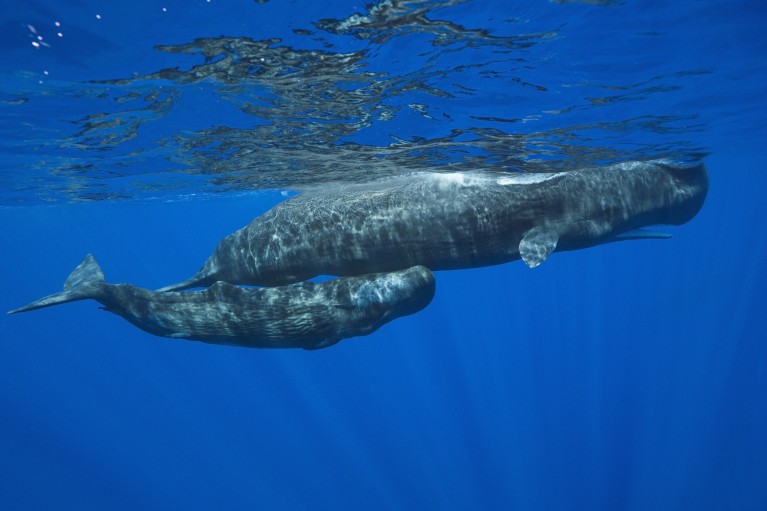
Sperm Whale Mother and Calf. Credit: Reinhard Dirscherl/ The Image Bank/ Getty Images
Sperm whales make a lot of noise. Their most frequent and commonly studied sounds are ‘clicks’, short and loud pulses made by compressing air through their respiratory system, and used to communicate and locate prey. But other sounds in their vocal repertoire have been less studied, including a ‘trumpet’ sound that they sometimes make at the beginning of the dive, first recorded in the Mediterranean Sea 25 years ago and occasionally documented in the Atlantic, at the Galapagos and near Sri Lanka.
“They sound like tonal sounds to the human ear,” explains Daniela Silvia Pace, researcher at the Department of Environmental Biology of the Università di Roma La Sapienza. Unlike clicks, trumpets do not seem to work for echolocation, the sensing system that allows whales to perceive distances based on how other objects reflect sounds. “Their modest level and the apparent lack of directionality seem to exclude that, and their possible role as a signal or a cue is still unclear,” says Pace.
Click to hear two examples of sperm whales' trumpet sounds recorded in the Mediterranean Sea
In order to understand their function, the researchers analysed the acoustic features of trumpet sounds recorded over several decades in the Pelagos Sanctuary area in the North-western Mediterranean Sea. The study1, published in Scientific Reports, was based on two sets of underwater recordings. One came from a brief campaign conducted by the Interdisciplinary Center on Bioacoustics and Environmental Research (CIBRA) at Università di Pavia in 1996, and contains the first trumpet recordings in the Mediterranean Sea. The second set was collected between 2007 and 2018 by the Tethys Research Institute, a non-profit organisation based in Milan.
“Young and adult male sperm whales have been reported in the area since 1990, mostly during the summer while foraging” says Caterina Lanfredi, a researcher at the Tethys Research Institute and co-lead author of the study with Pace. “Sperm whales do deep dives in search of food, and this area represents the ideal habitat for their prey, mainly cephalopods that hide in submarine canyons,” she notes.
While recording underwater sounds with hydrophones, the researchers were also taking pictures of the whales as they emerged. This way, they could later associate each recorded sound to the animal that had made it.
During more than 700 hours of recordings, the scientists identified 230 trumpet sounds from 68 ‘trumpeter’ whales. “At least half of the known whales in the area emitted trumpets each year, showing the persistence of this sound in the area and in the same individuals over a long period,” notes Pace. The scientists also found evidence that some features of the sound change with intense social interactions. “When more than one whale is present in the area, the trumpet duration is longer and the initial frequency is higher” says Pace. Trumpets were also often associated with particular, stereotyped sequence of clicks called ‘codas’, that researchers believe are used in social communication in both sexes, and with ‘slow clicks’, male-only long-range communication signals used for attracting females.
The scientists now suggest that trumpets are sounds made by maturing or mature males to interact with other males during foraging. “The Mediterranean population of sperm whales is at risk of extinction, and understanding better their ecology and behaviour is critical for their conservation" says Lanfredi.
